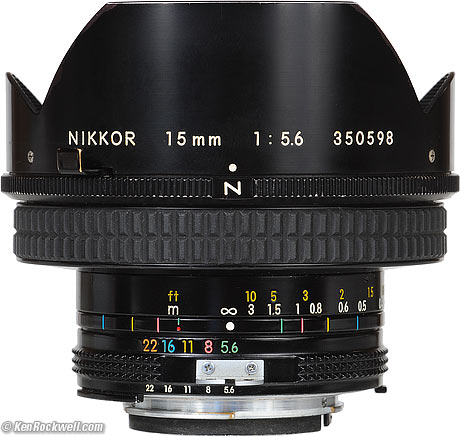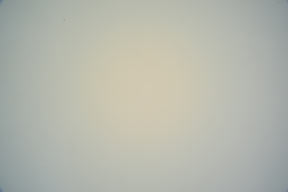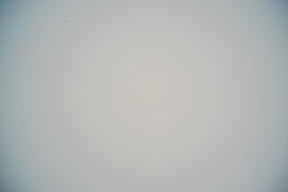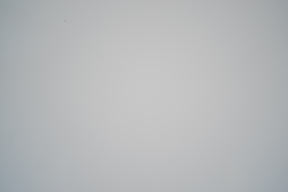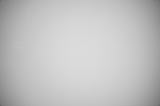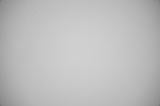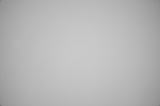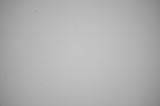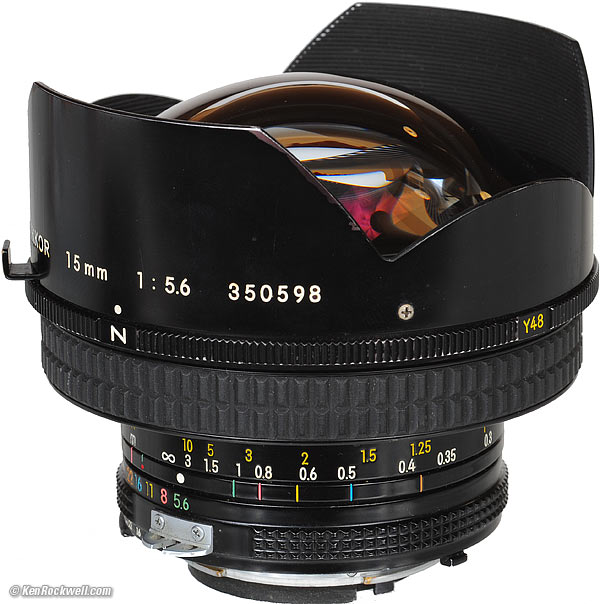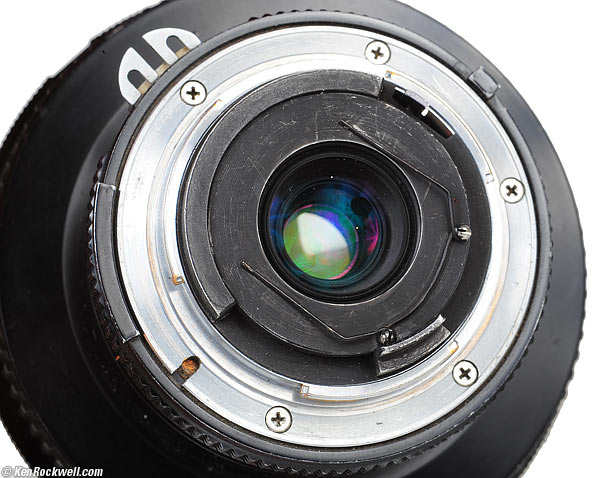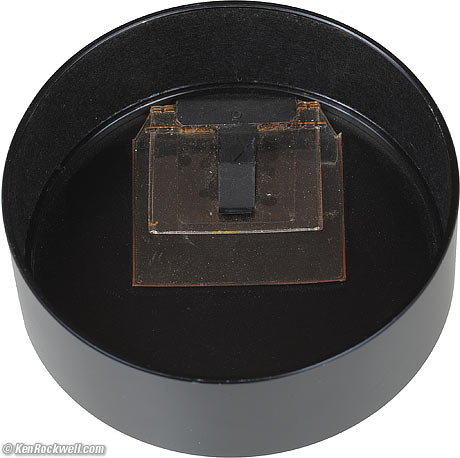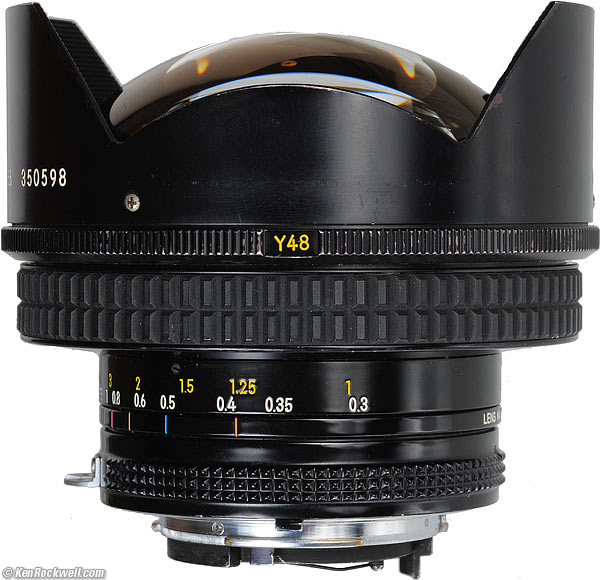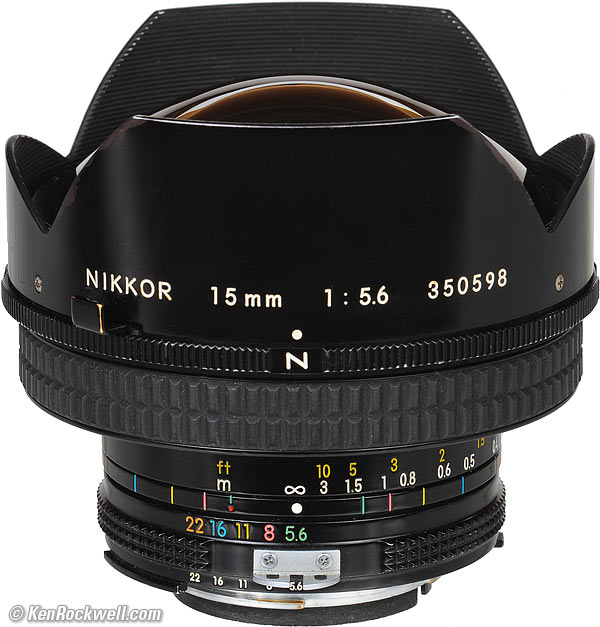Home Donate New Search Gallery How-To Books Links Workshops About Contact
Nikon
15mm f/5.6
NIKKOR (1973-1978) (This AI version: 1977-1978)
© 2008 KenRockwell.com. All rights reserved.
Nikon 15mm f/5.6 AI (internal and rear gel filters, 22.9 oz./650g, about $600). enlarge. This free website's biggest source of support is when you use any of these links, especially this direct link to this lens at eBay (see How to Win at eBay), or to it at Adorama, when you get anything, regardless of the country in which you live. Thanks! Ken.
Nikon Ultra-Ultrawide Lens Comparison 23 December 2008
How to Use Ultrawide Lenses 11 August 2008
February 2008 More Nikon Reviews
Best for
Ultra-ultra wide special effects shots on film and FX. Don't bother with it for DX digital; get the 12-24mm DX instead.
Optical Quality
Very Good (excellent sharpness and freedom from distortion, but only fair color transmission).
Ease-of-use
Very Good.
Usefulness
Excellent, for ultra-ultra wide use.
Introduction top
Intro Specifications Performance Recommendations
This is a rare and exotic lens.
As old as it is, it works extremely well today's newest D3. It has far less distortion than the far more expensive 14-24mm zoom lens introduced in 2007.
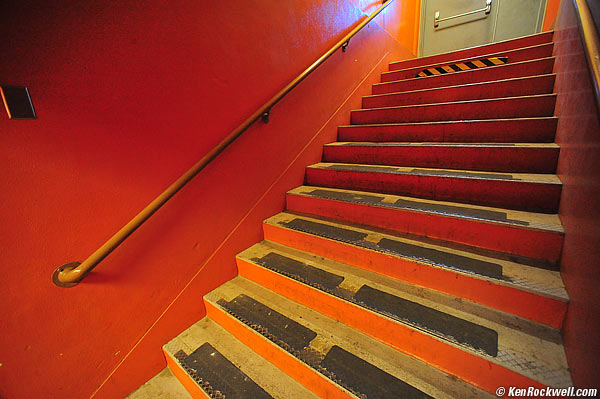
Stairs. Nikon 15mm f/5.6 at f/5.6, Nikon D3 auto ISO chose ISO 4,500 and 1/15.
This 15mm f/5.6 lens works far better on an F6 or the D3 today than it ever did on film cameras. The slow f/5.6 aperture caused the split-image rangefinders of manual focus cameras to black out, often necessitating the use of a special interchangeable focus screen. The slow f/5.6 speed isn't an issue with today's brighter viewfinders and electronic manual focusing.
Its optics are as good as all of Nikon's other fixed ultra-ultra wide lenses: its contemporary, the ultra-exotic 13mm f/5.6, its successor the 15mm f/3.5, and the 14mm f/2.8 AF. The newest 14-24mm f/2.8 is sharper, but has more distortion.
Size Comparison among all other Nikon ultra-ultra wide lenses. enlarge.
Nikon 13mm f/5.6, this 15mm f/5.6, 15mm f/3.5, 14mm f/2.8 and 14-24mm f/2.8.
Compatibility
Be sure to get an AI version, or an older version which has been updated to AI. If you get an older non-AI version, it won't even mount on any modern camera.
On the D3, D300, D200, D2 and F6, use the "Non-CPU Lens Data" menu option to set 15mm and f/5.6 to get full matrix metering, EXIF data and finder read-out of set aperture. It works great in aperture-preferred as well as manual modes on these cameras.
The meters of cheaper digital (D80 and below) and cheaper film cameras (N80 and below) will not couple (or work at all) with this lens, so you'll be on your own guessing exposure using the rear LCD or an external meter.
It works perfectly every professional film camera (F, F2, F3, F4, F5, F6), and adds Matrix metering on the FA, F4 and F6.
See Nikon Lens Compatibility for details on your camera. Read down the "AI, AI-s" column for this lens. If you have a non-AI version, read from the "Pre-AI" column.
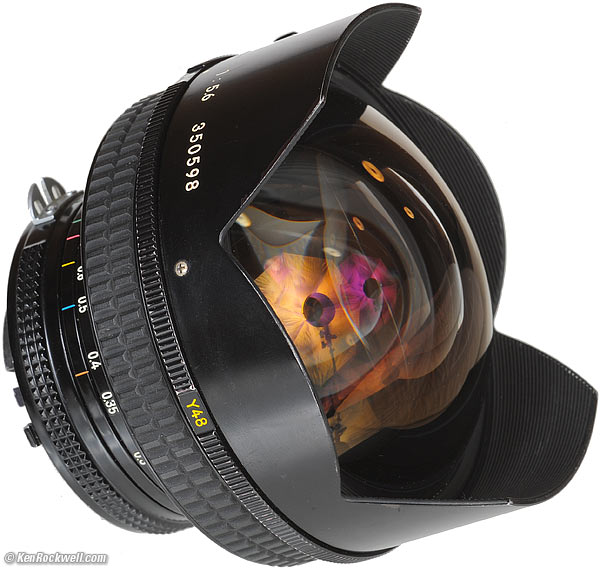
Nikon 15mm f/5.6.
History
Nikon tempted the world in 1972 with a 15mm lens in its catalogs, but it never saw production.
This real lens was introduced In the summer of 1973 as the most insanely wide lens in all of 35mm photography.
The optics of the 15mm f/5.6 were unchanged as the mechanics of the lens went through a few changes. This f/5.6 lens was replaced by the faster 15mm f/3.5 of 1978.
c. 1972
A NIKKOR-PD was seen in catalogs, but never produced for sale or assigned a product number. It had 15 vs. 14 elements, weighed only 19.8 oz (560g) vs. 22.8 oz (645g) and a skylight instead of the clear default filter of the newer models.
1973-1976
NIKKOR-QD C. This first production version had a diamond-pattern rubber focus ring and a chrome filter release tab.
1976-1977
Now simply called NIKKOR, and the rubber was the classic rectangular waffle pattern.
1977-1978
Updated to the AI version reviewed here.
Summer 1978: Replaced by the 15mm f/3.5 AI-s.
Production Quantities and Pricing
Olden Camera advertised these for $804.50 in June of 1977, or the equivalent of $2,800 in today's money considering inflation.
Since they have always been so expensive, Nikon never sold very many.
Nikon made about 2,500 of the non-AI versions, and probably less than 1,000 of the AI version shown here.
In 2008, I've seen them for sale used for $899.
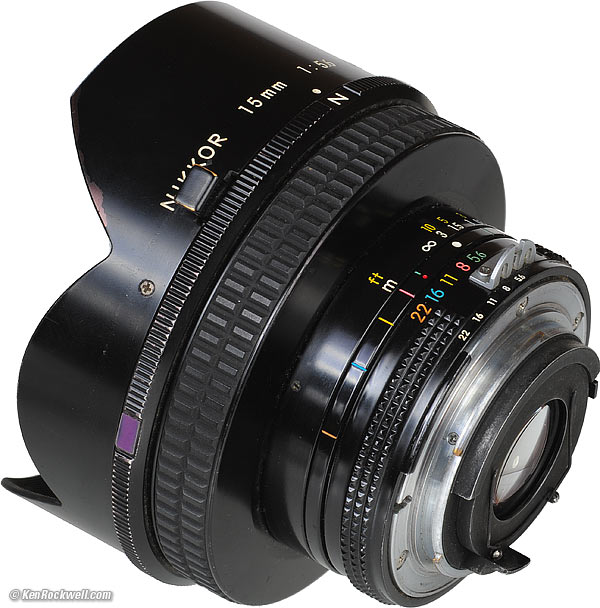
Nikon 15mm f/5.6. Note purple sticker on filter ring denoting swapped FLD filter.
Specifications top
Intro Specifications Performance Recommendations
Name
Nikon calls this the Nikon Nikkor 15mm f/5.6 AI.
Optics
14 elements in 12 groups.
Nikon Integrated Coating (NIC).
Floating-element close-range correction (CRC).
Actual Focal Length
15.3mm.
If you're silly enough to use it on a DX camera, it gives angles of view similar to what a 23mm lens would give on an FX or 35mm film camera. See also Crop Factor.
Angles of View (FX and film):
Diagonal: 110º
Horizontal: 100º
Vertical: 77º
Diaphragm
7 blades, stopping down to f/22.
Focus Ring
The whole middle of the lens rotates: the rubber-covered focus ring and the distance scale rotate. The front stays put, although it extends a fraction of a millimeter as you focus more closely.
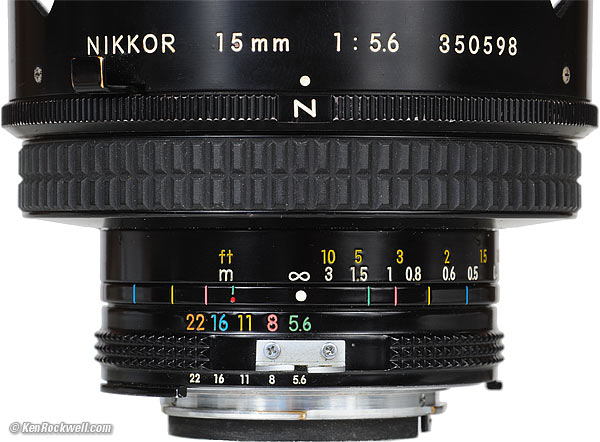
Nikon 15mm f/5.6 focus ring.
Hard Infinity Focus Stop?
Yes.
Close Focus
1 foot (0.3m).
Maximum Reproduction Ratio
1:13.7.
Focus Distance Scale?
Yes.
Depth-of Field Scale?
Yes.
Infra-Red Focus Index?
Yes, red dot below the depth-of-field mark for f/5.6.
Filters
Four internal filters and rear gels. See filters below for more.
Size
3.000" extension from flange (focused at infinity) x 3.618" diameter (76.2 x 91.90 mm), measured.
The widest thing is the filter selector ring. The hood-like protuberance measures an exact 90.00mm in diameter. Nikon specifies 76mm extension from flange and 92mm diameter.
Weight
22.920 oz. (649.8g), measured, no caps.
The aluminum front cap adds an additional 2.480 oz (70.3g). Nikon specifies 22.8 oz. (645g).
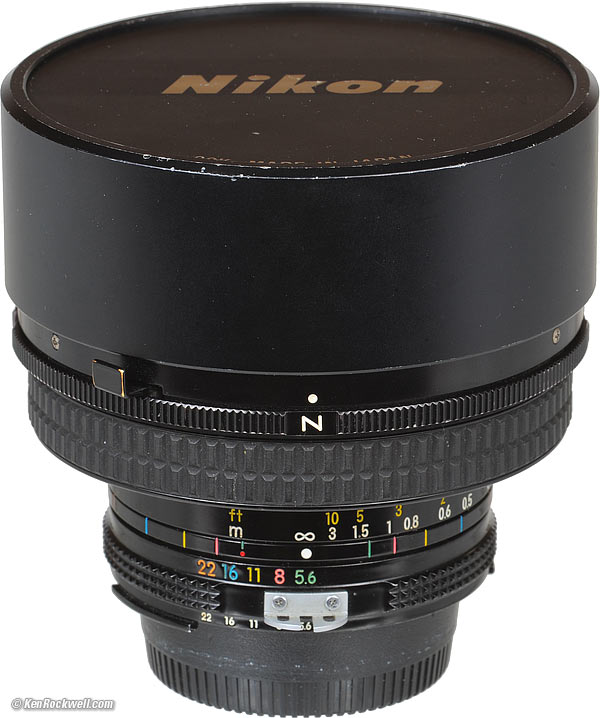
Nikon 15mm f/5.6 with 90K slip-on front cap.
Front Cap
90K slip-on felt-lined metal, with a holder for spare gel filters inside!
Case
CL-26.
Hood
None. The metal extending in front of the lens is mostly for protecting the glass from impacts.
Performance top
Intro Specifications Performance Recommendations
Color Transmission Peripheral Color Falloff
Filters Focus Ghosts Mechanics Sharpness
Overall
Performance is excellent. It has no weak points except for some color shifts in the corners. It's sharp and almost distortion-free; one of the highest performance ultra-ultra-wides ever made.
Yes, it's only f/5.6, but unlike most of Nikon's lenses, it doesn't lose performance wide-open. Shoot it at f/5.6 and it works great.
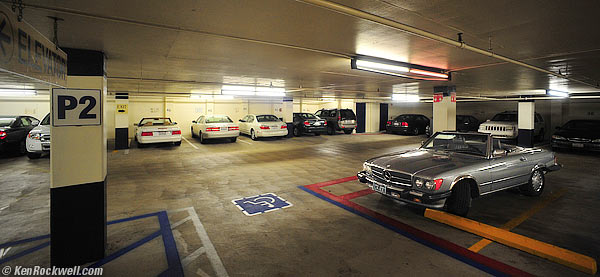
Instant La Jolla Panorama (just cropped-off top and bottom). Nikon 15mm f/5.6 at f/5.6, Nikon D3 auto ISO chose ISO 1,250 and 1/15.
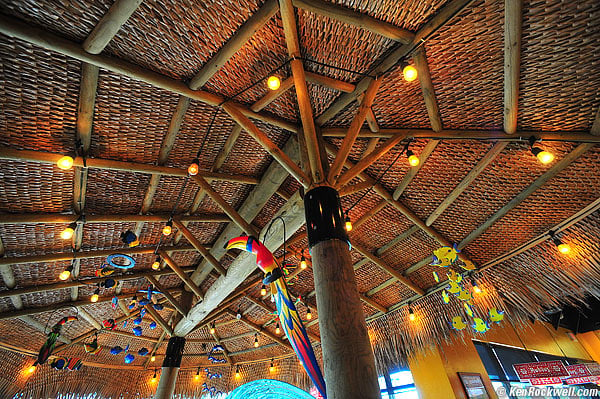
Rubio's. Nikon 15mm f/5.6 at f/8, Nikon D3 auto ISO chose ISO 720, aperture-priority chose 1/15.
Color Transmission (Color Balance) back to Performance or top
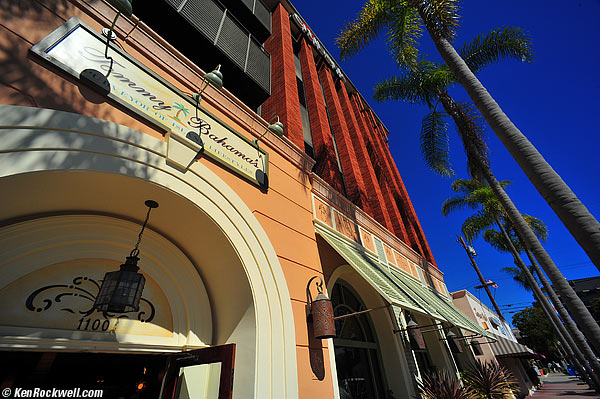
La Jolla, CA. Nikon 15mm f/5.6 at f/11 and 1/1,000, Nikon D3 at ISO 400.
The 15mm f/5.6 renders bold, sharp colors like every other lens. That's not what I'm discussing here. Here I'm discussing color transmission; the overall skew or bias of colors one way or the other. just as if one used a mildly colored filter.
This 15mm f/5.6 is slightly more yellow than my other lenses. It looks this way through the finder more than it does in actual photos, since auto white balance tends to compensate for it.
It's almost as if the "N" filter is really a Nikon L39 filter, popular at the time, which was a stronger and very slightly more yellow filter than the clear (NC) or UV (L37c) filters of today.
Here's what happens if I set a manual preset white balance for a neutral reference with my 14-24mm. I then shot the other lenses at the same WB, which shows us how they differ in color.
Center and Peripheral Color Balance Comparison
|
Look very carefully and you'll see the corners get bluer. You can see the bluer corners in real photos. The overall differences in color balance cancel out if you set WB using the same lens with which you're shooting. If I set WB using this 15/5.6, its center would be neutral and its corners, and the other lenses, would look bluer.
This brings us to the next discussion, peripheral (corner) color shift.
Peripheral (corner) Color Shifts back to Performance or top
Lens coatings become less effective at longer (redder) wavelengths as the light's angle of incidence increases. In other words, when the light hits a lens sideways, more red light gets reflected and less gets transmitted, making for a cooler color balance in the corners of extremely wide lenses.
I've seen this effect on film with my ultra-wide lenses on my 4x5 and other film cameras for years, and I see it with my digital cameras and these older ultra-ultra wide lenses.
It's rarely a problem, but of you put a big wall in your image, you'll see it.

La Jolla Post Office. Nikon 15mm f/5.6 at f/11 and 1/2,000, Nikon D3 at ISO 400.
See how the wall on the left and far right gets not only dimmer, but cooler? That's what this lens, as well as the 15mm f/3.5 and 14mm f/2.8 do. If this concerns you, the 14-24mm f/2.8 does much better.
If you missed it, I just showed this with flat targets above.
What about the Chief Ray effect?
The Chief Ray effect describes what happens when light hits a CCD at a weird angle, as it can in the corners. If the angle is too severe for the sensor, the light goes through the microlenses the wrong way and misses the photosites, or crazier, may hit the photosites for different colors! Whoops!
The color shifts with these ultra-wide lenses in the corners of the D3 are not caused by this because:
1.) Although this effect can be serious for non-SLR cameras like camera phones, the Leica M8 (wonder why its still not full-frame?) and point-and-shoots, wide SLR lenses use retrofocus designs so that the rear of the lens stays far enough out of the camera to avoid the flipping SLR mirror. Even these ultra-ultra wide lenses have their rear exit pupils at about the same position as with a normal lens. (The rear pupil is the apparent hole in the diaphragm blades.)
The incident light at the corner of an SLR sensor is at about the same angle with ultra-ultra wide lenses as it is with normal lenses. The light comes out of retrofocus lenses at different angles then they enter; that's why the front elements are so huge and the rear elements normal sized, or even smaller than with 50mm lenses.
2.) Chief Ray effects often result in shifts to different colors depending on the direction of the light for the same incident angle. Light coming from different directions may not just be partly missing a photosite, it could miss and hit the wrong photosite and be interpreted as a different color!
In these examples we're seeing the same color shift in each corner, regardless of direction around the compass. Anti-alias filters help prevent this, too.
3.) Unlike testing the vast destructive power of America's recently deployed network of space-based nuclear-pumped lasers (what do you thing the Space Shuttle missions were all about these past 20 years?), these optical effects are easy to explore at home. Trying these lenses on film I see the same effects as shown above on the D3.
It's caused by the lens, not the sensor interface.
Historical note: Most people think the Chief Ray effect is named after the optical term for the ray which goes directly through the center of the lens, the chief ray. In fact, the Chief Ray effect is named after its discoverer, Oneida Indian Chief Ray "Howling Wolf" Natisquonk who first documented this effect in the early 1800s near Syracuse, New York. His work involved characterizing the effects of light as it passed through patterns of sequins as applied to cloth.
Distortion back to Performance or top
Unlike almost every other Nikon wide-angle and fast normal lens, the Nikon 15mm f/5.6 has no distortion except some barrel distortion at the closest distances. It has some distortion used on a DX camera, but it's silly to do so since the 12-24mm DX is so much better for DX cameras.
It has distortion on DX cameras because it has a bit of a pot belly. Shoot a wall on FX and the sides are all perfect, but the center bulges out a little bit. This shot below was made from about 6 feet (2m) away. You'll see the tiles on the floor along the bottom are perfect, but the ticket-holding boxes bulge just a little. This shot would look relatively awful as shot with the 14-24mm f/2.8. Of course the 12-24mm DX or any DX camera simply can't go this wide.
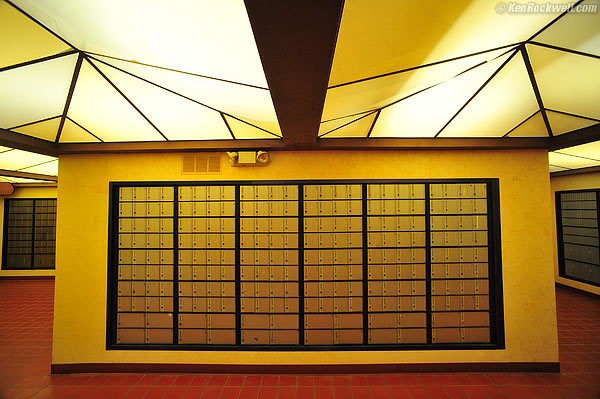
Swiss Railway Station. Nikon 15mm f/5.6 at f/5.6, Nikon D3, auto ISO chose ISO 640 and 1/15.
Plug these figures into Photoshop CS2's lens distortion filter to correct the distortion. These aren't facts or specifications, they are the results of my research that requires hours of photography and calculations on the resulting data.
FX and scanned film |
||
Infinity |
0.0* |
+1.5 |
30' (10m) |
0.0* |
+1.5 |
10' (3m) |
+0.4 |
+1.2 |
6' (2m) |
+0.4 |
+2.0 |
3' (1m) |
+1.2 |
+2.1 |
1' (0.3m) |
+6.0 |
+4.0 |
© 2008 KenRockwell.com
* invisible waviness ("moustache" distortion) remains, only +/- 4 pixels at 12MP FX resolution.
Falloff (dark corners) back to Performance or top
It has very little falloff, even wide open. Feel free to shoot at f/5.6 if you need it.
These shots of a flat lab surface exaggerate the falloff. These shots are made in the D3's black-and-white mode, so you won;t see and of the corner color shifts here.
Falloff isn't a problem even wide-open at f/5.6. The only issue is the peripheral color issue covered above, which means the falloff is much greater in the red channel than the green channel, and the blue channel is completely even.

